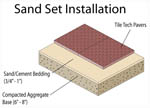Easy Installation of Interlocking Pavers?

There are many talks regarding the properties and features of the interlocking pavers and what makes it stand out above the rest of the paver materials on the market today. It is definitely enticing to look into the features of this marvelous design such as the interlocking mechanism and the primary construction of the paver itself. However, a point of emphasis should also be maintained in looking into the interlocking pavers installation process which is a very grand and intricate feature.
The question of how to install interlocking pavers is as important as the features of the interlocking paver itself. The installation mechanism is a reflection of the overall construction of the paver and also the durability and vitality that it has. As the interlocking paver is inspired by the principles of interlocked materials, the interlocking pavers are indeed a work of art. Since pavers are actually meant to be walked and drove on, it is extremely important to look into the proper installation of this spectacular paver.
How to Install Interlocking Pavers

The interlocking pavers installation is as easy as it sounds. The only material that is needed in the question of how to install interlocking pavers is the tamping machine which is also known as the vibrating compactor. Basing on the name itself, this device presses the sand which acts as the bases of the interlocking paver itself. The compacted sand acts as a stabilizer and maintains the composure of the interlocked pavers. This nullifies the shaky feel that other paver have when walked or stepped on. But the sand does not only stabilize the pavers, it also facilitates the flexibility allowing movement of the pavers. For this particular reason, the pavers have a minimal risk of breaking or cracking.
The easy interlocking pavers installation process benefits the homeowners in that they can install their own pavers at their own time. This does not only eliminate wasteful transactions only for installation, one also gets to have a first-hand experience of getting his own roads paved. Also, the homeowners can get their interlocking pavers installed exactly the way they want it to be. Now the problem of how to install interlocking pavers is answered.
Moreover, a helpful tip in the interlocking pavers installation process would be placing a few pavers near the paver installation. This enables the pavers themselves to wear and age with the other pavers. Also, the replacement of other pavers if and when they become damaged or worn out would be an easy task because of the stacked pavers. This makes the process of how to install interlocking pavers a piece of cake.
Interlocking paving systems are so easy to install, since they don’t need mortar to hold them together. They are laid on a bed of sand and the joints are stabilized with the use of sand particles. The sand not only stabilizes the interlocking pavers, but also allows them some flexibility and movement. This will inevitably prevent cracks from heavy use or harsh weather conditions.
Laying interlocking pavers is so easy that any homeowner could accomplish it. This will mean you will save a lot of money on installation costs. The only tool you will really need is a tamping machine, otherwise known as a vibrating compactor. This machine allows you to compact your sand base efficiently.
Since a few pavers might need replaced years down the road it is sometimes useful to place a few pavers in an area near to your interlocking pavers installation so that they wear and age with the other pavers. Then if you do need to replace a paver in your installation you have one right there.
